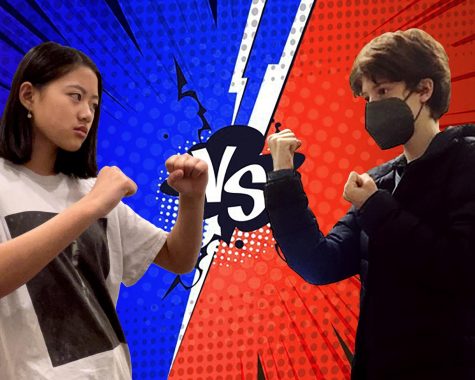Should There be a Virtual Option for School?
January 28, 2022

Yes, BLS Should Switch to a Remote Learning Model
The strikingly low attendance among the Boston Latin School community is becoming a new norm. Classrooms have not looked the same since the pandemic, and the latest surge of the Omicron variant has further altered the atmosphere of schools across the country, especially at BLS. With over 51,000 positive COVID-19 cases and the 20 percent absence rate in Massachusetts schools alone, Governor Charlie Baker and the Massachusetts Department of Elementary and Secondary Education (DESE) should consider virtual learning as an option to relieve the overstretched education system.
Governor Baker and Massachusetts officials are upholding a false sense of normalcy that jeopardizes both the individual and overall health of school communities. As with other issues, the more options the better, so why isn’t virtual learning on the table? The recent rise in cases has only highlighted the lack of protection and unsafe situations students and staff are exposed to every day. Virtual learning is a safer alternative that offers flexibility and adaptability with the rapidly mutating COVID-19 variant.
While going completely remote certainly has many negative effects because not all students can learn through a screen, it is crucial to understand that when discussing a virtual option, it is about giving schools the autonomy to make decisions that work best for their community.
Incorporating remote learning days opens up safer arrangements for individuals who need to quarantine. Staff shortages and large class absences would be accounted for, as students and teachers with COVID-19 could attend classes from the safety of their home.
When asked about her COVID-19 quarantining experience, Keeva Donoghue (III) says, “I didn’t have very harsh symptoms. […] I definitely feel like there were no symptoms that were stopping me from being able to take notes if I was in a virtual class or paying attention or attending class if it was virtual.” Many other students share similar experiences with Donoghue, where the largest effect of COVID-19 was the pressure and stress from falling behind in school. BLS English teacher Ms. Lynn Burke also agrees that “if we went remote, we would be able to keep everybody on the same page.”
Not only does virtual learning accommodate infected people, it also prevents infection among the immediate and extended members of the school community. Particularly for students who are awaiting COVID-19 test results or have family members positive with COVID-19, a virtual option significantly reduces the risk of transmission to high-risk family members with underlying health conditions.
William Hu (I) says, “They should have the option to be at home and feel safe, and it opens up so much more space for those who need to go in person.” As Hu points out, COVID-19 hotspots like the cafeteria, auditorium, staircases, hallways and entrance ways would be less crowded. Those who do need to attend in-person school due to varying home situations would be in overall safer learning conditions.
Pushing for a remote option in Massachusetts schools means a greater say in their approach to the recent COVID-19 surges, which promotes better physical and mental well-being in all school communities. In such an uncertain time and unwavering administration, it is critical to make one’s voice heard. Sign petitions and share information about the lack of choices for Massachusetts schools, and as Hu sums up, “[The governor’s administration and DESE] are not really giving us the option to feel safe, [but] safety shouldn’t be an option. It should be a right.”
No, BLS Should Not Switch to a Remote Learning Model
With the recent surge of the highly contagious COVID-19 Omicron variant, many Boston Latin School students and staff have raised concerns about the school staying open with no virtual option.
Though these concerns are understandable, a BLS remote response to this virus would disrupt students’ social and academic development. It would also place a heavy burden on struggling families to find the resources necessary for their students to thrive. Going remote is neither a fair nor ideal solution to education during a pandemic.
According to the Centers for Disease Control and Prevention (CDC), only 582 people under the age of 18 have died solely from COVID-19 since 2020, well under one percent of the youth population of the United States.
The risk of death in the BLS community and in the families of students is further reduced since Boston Public Schools has extended its mask mandate to February 28. Furthermore, the majority of BLS community members have been vaccinated against COVID-19, with students now having the opportunity to get the booster as well.
The fully remote model of 2020-2021, with students attending all classes through Zoom, wreaked havoc on student mental health. Many were isolated from real social interactions with people their age. Tragically, according to the CDC, suicide rates among youth were skyrocketing, with suicide attempts among girls aged 12 to 17 increasing 50 percent in 2021 compared to 2017.
Though it may seem ordinary, face-to-face interaction and social development — both which school provides students — is crucial, fragile and irreplaceable by online interaction. “It made me more stressed […] to not be able to be in the building and interact with people face to face. I lost some social development,” says Lorelei Currier (IV).
This sentiment is not unique. Anxiety and depression, particularly among high school students, rose dramatically over the course of school lockdowns. Guidance counselor Ms. Elaine Sylvester states, “I think there was an uptick [in mental health issues]. Being able to put eyes on students, students being able to put eyes on teachers and peers […] really helps socialization and mental health.”
The mental health challenges that isolation provoke are further exacerbated by the stress of remote learning. For many families, remote learning can be a nightmare scenario for parents who are unable to stay home with their kids during the day or for students who lack adequate access to Wi-Fi and technology. Online learning is not a realistic or beneficial option for students whose home life cannot support it.
Remote learning also has a negative effect on student academic performance. Due to declining mental health and the convenience of cheating, and consequently falling behind, during the disengaged style of remote learning, an overwhelming number of students struggled to complete assignments, take assessments with academic honesty and even show up for class.
BLS Classics teacher Mr. Patrick Finnigan explains, “There are students who have more responsibilities at home. Not having the structure of being in school, [or] having a common touchpoint with adults to keep you going, was harmful.”
Now that students have returned to the engaging, in-person style of learning, the contrast between the two learning methods is clear: sitting in a house all day on Zoom is not a replacement for the academic support, basic levels of social interaction, daily routine and healthy environment that in-person learning offers. Going back to remote learning would be an ultimate disaster.
